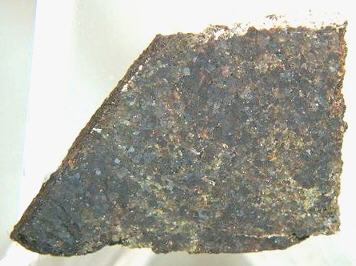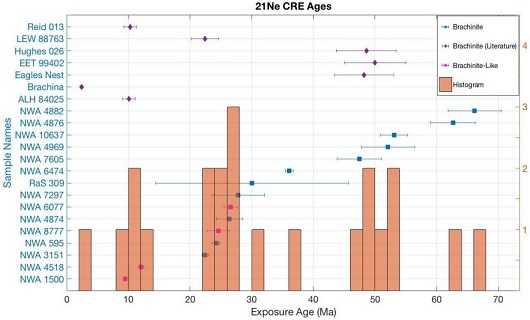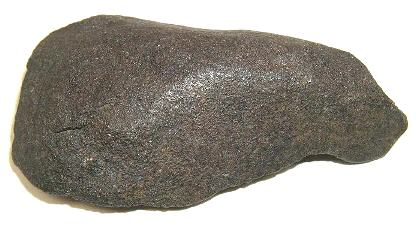Brachinite

Found 2007
no coordinates recorded A portion of a fresh, fusion-crusted stone weighing 180 g was found in Northwest Africa and subsequently purchased by M. Cimala in Erfoud, Morocco. A type specimen was submitted for analysis to Northern Arizona University (J. Wittke and T. Bunch), and NWA 4969 was classified as a new brachinite. This brachinite might be paired with other brachinites found in Northwest Africa during a similar timeframe (e.g., NWA 4042, 4872, 4874, 4882 [the largest brachinite mass known], and 6349).
Northwest Africa 4969 is an olivine-rich (~89 vol%) dunite with a protogranular texture typical of this group. It has a bimodal grainsize, ranging from fine- to medium-grained (0.1 mm to 1.2 mm), and contains minor clinopyroxene, K-poor sodic
plagioclaseAlso referred to as the plagioclase feldspar series. Plagioclase is a common rock-forming series of feldspar minerals containing a continuous solid solution of calcium and sodium: (Na1-x,Cax)(Alx+1,Si1-x)Si2O8 where x = 0 to 1. The Ca-rich end-member is called anorthite (pure anorthite has formula: CaAl2Si2O8) and the Na-rich end-member is albite Click on Term to Read More,
chromiteBrownish-black oxide of chromium and iron (Cr-Fe oxide), Cr2FeO4, found in many meteorite groups. Click on Term to Read More, and FeNi-metal. Similar to some other brachinites, olivines contain very fine-grained assemblages of
orthopyroxeneOrthorhombic, low-Ca pyroxene common in chondrites. Its compositional range runs from all Mg-rich enstatite, MgSiO3 to Fe-rich ferrosilite, FeSiO3. These end-members form an almost complete solid solution where Mg2+ substitutes for Fe2+ up to about 90 mol. % and Ca substitutes no more than ~5 mol. % (higher Ca2+ contents occur Click on Term to Read More and opaques (
metalElement that readily forms cations and has metallic bonds; sometimes said to be similar to a cation in a cloud of electrons. The metals are one of the three groups of elements as distinguished by their ionization and bonding properties, along with the metalloids and nonmetals. A diagonal line drawn Click on Term to Read More and sulfide) lining various
olivineGroup of silicate minerals, (Mg,Fe)2SiO4, with the compositional endpoints of forsterite (Mg2SiO4) and fayalite (Fe2SiO4). Olivine is commonly found in all chondrites within both the matrix and chondrules, achondrites including most primitive achondrites and some evolved achondrites, in pallasites as large yellow-green crystals (brown when terrestrialized), in the silicate portion Click on Term to Read More grain boundaries, features which have been attributed to fluctuations in
redoxOxidation and reduction together are called redox (reduction and oxidation) and generally characterized by the transfer of electrons between chemical species, like molecules, atoms or ions, where one species undergoes oxidation, a loss of electrons, while another species undergoes reduction, a gain of electrons. This transfer of electrons between reactants Click on Term to Read More conditions (
e.g., Rumble III
et al, 2008). Several methods for the
reductionOxidation and reduction together are called redox (reduction and oxidation) and generally characterized by the transfer of electrons between chemical species, like molecules, atoms or ions, where one species undergoes oxidation, a loss of electrons, while another species undergoes reduction, a gain of electrons. This transfer of electrons between reactants Click on Term to Read More of primary olivine were reviewed by Goodrich
et al., 2017), including its reaction with methane to form orthopyroxene + metal (Irving
et al., 2013) and through its sulfurization by a S-rich fluid or gas to form orthopyroxene + sulfide (
e.g., Singerling
et al., 2013).
The formation age of the paired brachinite NWA 4882 was calculated by Dunlap
et al. (2016) using the short-lived Mn–Cr chronometer. An absolute age relative to the D’Orbigny age anchor was determined to be 4.5502 (±0.0008) b.y. This is ~14.6 m.y. later than the formation of the type specimen for this group, Brachina, which has a Mn–Cr age of 4.5648 (±0.0005) b.y. (Dunlap
et al., 2016). In addition, their study revealed that the ε
54Cr value for this
meteoriteWork in progress. A solid natural object reaching a planet’s surface from interplanetary space. Solid portion of a meteoroid that survives its fall to Earth, or some other body. Meteorites are classified as stony meteorites, iron meteorites, and stony-iron meteorites. These groups are further divided according to their mineralogy and Click on Term to Read More is similar to that of other brachinites, indicating that they all derive from a common
parent bodyThe body from which a meteorite or meteoroid was derived prior to its ejection. Some parent bodies were destroyed early in the formation of our Solar System, while others like the asteroid 4-Vesta and Mars are still observable today. Click on Term to Read More that experienced a long duration of impact-heating. In a subsequent study, Dunlap
et al. (2017) determined a very ancient Al–Mg absolute age relative to D’Orbigny of 4.5680 (±0.0005) b.y., possibly reflecting the time of
partial meltingAn igneous process whereby rocks melt and the resulting magma is comprised of the remaining partially melted rock (sometimes called restite) and a liquid whose composition differs from the original rock. Partial melting occurs because nearly all rocks are made up of different minerals, each of which has a different melting Click on Term to Read More of the source lithology.
Many of the known brachinites have disparate cosmic-ray exposure ages, indicating that they represent numerous separate ejection events. According to a study by Patzer
et al. (2003), the CRE ages of EET 99402/407, Hughes 026, and Eagles Nest form a cluster at ~48 m.y., and those of Reid 013 and ALH 84025 coincide at ~10 m.y. In a separate study by Ma
et al. (2003), the cosmogenic
nuclideA nuclear species characterized by Z protons and N neutrons. Click on Term to Read More calculations establish a range of CRE ages from 4 m.y. for Brachina to ~25.5 m.y. for Eagles Nest. From their
noble gasElement occurring in the right-most column of the periodic table; also called "inert" gases. In these gases, the outer electron shell is completely filled, making them very unreactive. Click on Term to Read More analyses of 15 brachinite and brachinite-like meteorites, together with the literature values for seven others, Beard
et al. (2018) identified three potential CRE age clusters. The oldest cluster reflects a possible ejection event that occurred ~49.9 (±4.1) m.y. ago, comprising the six brachinites Eagles Nest, EET 99402, Hughes 026, NWA 4969, NWA 7605, and NWA 10637. Importantly, two of these CRE age clusters include both brachinite and brachinite-like meteorites, which attests to a common parent body for all of these meteorites (see diagram below).
 click on image for a magnified view
click on image for a magnified view
Diagram credit: Beard
et al., 81st MetSoc,
#6170 (2018) Information concerning the origin and petrogenesis of the brachinites and the meteorite GRA 06128/9, considered to be a possible representative of the feldspathic
crustOutermost layer of a differentiated planet, asteroid or moon, usually consisting of silicate rock and extending no more than 10s of km from the surface. The term is also applied to icy bodies, in which case it is composed of ices, frozen gases, and accumulated meteoritic material. On Earth, the Click on Term to Read More of the brachinite parent body, can be found on the
NWA 3151,
Reid 013, and
Eagles Nest pages. The specimen of NWA 4969 shown above is a 0.93 g partial slice. The photo below shows the partial stone as found.

Photo courtesy of Marcin Cimala—
Polish Meteorite Laboratory









